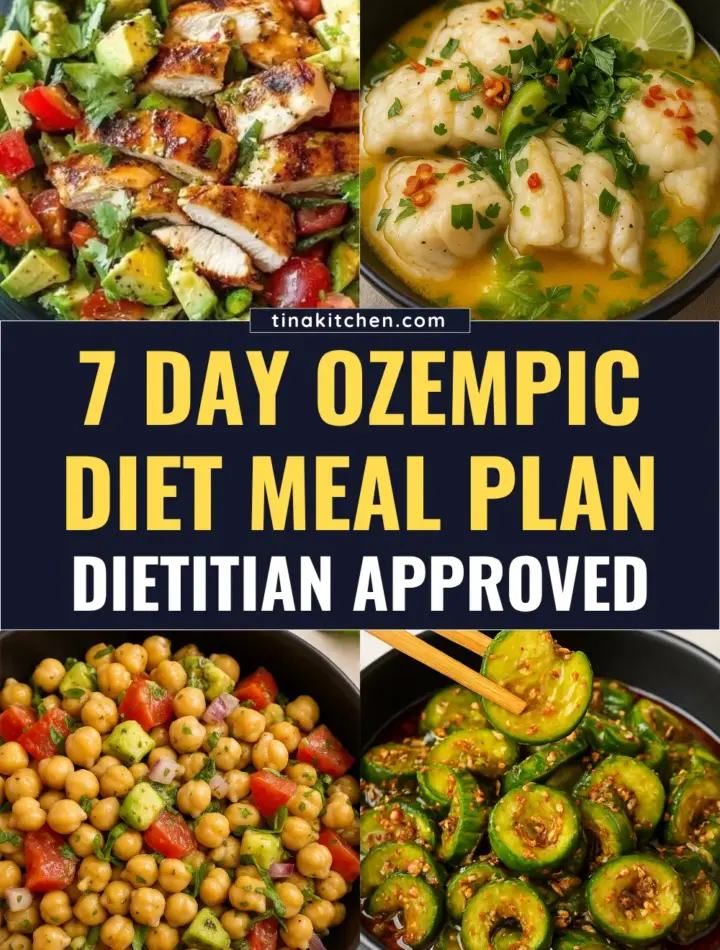This post may contain affiliate links, meaning I may earn a commission if you make a purchase, at no extra cost to you. I only recommend products I trust. Thank you for your support.
Table of Contents
What is Ozempic?
Ozempic (semaglutide) is a GLP-1 medication prescribed for type 2 diabetes and weight management. It works by reducing appetite and slowing stomach emptying.
Ozempic (semaglutide) works by mimicking a natural hormone in the body called GLP-1. This helps regulate blood sugar, slow down digestion, and make you feel fuller for longer, which can reduce overeating.
However, lasting weight loss and stable blood sugar don’t come from the medication alone. They also depend on following a balanced Ozempic diet meal plan or semaglutide diet plan that’s rich in protein and fiber.
In fact, experts advise that people taking Ozempic should aim for a diet rich in lean proteins, non-starchy vegetables, whole grains, and healthy fats to stabilize blood sugar and stay full longer.
What is the Ozempic Diet Plan?
The Ozempic diet plan isn’t a strict, one-size-fits-all diet but rather a nutrition approach designed to complement Ozempic (semaglutide).
Since Ozempic slows digestion, reduces appetite, and helps control blood sugar, the diet focuses on foods that support fullness, stable energy, and overall health.
The best diet for Ozempic focuses on lean protein, high-fiber vegetables, whole grains, and healthy fats, while minimizing processed, high-fat, and high-sugar foods.
Foods to Eat on Ozempic
To make the most of your Ozempic meal plan, focus on nutrient-dense, low-calorie, high fiber foods that support blood sugar control. Key components include:
- Lean Proteins: Prioritize chicken, turkey, fish, eggs, tofu, lean beef, and legumes. Lean meats and plant proteins supply satiety and nutrients without excess fats. Aim for at least 60 to 80 grams of protein per day.
- Non-Starchy Vegetables: Load your plate with leafy greens (spinach, kale), cruciferous veggies (broccoli, cauliflower, Brussels sprouts), bell peppers, carrots, tomatoes, onions, cucumbers, zucchini, and similar colorful veggies. These are very low in calories but high in fiber and water, which fill you up and curb hunger.
- Whole Grains and Legumes: Whole grains and legumes digest slowly, keeping blood sugar more stable. Foods like brown rice, quinoa, whole-wheat bread or pasta, steel-cut oats, beans, lentils, and sweet potatoes provide energy and fiber.
- Low Sugar Fruits: Choose lower-sugar fruits like berries, apples, pears, peaches, and citrus. These offer vitamins and fiber. (Limit high-sugar choices like mango or watermelon if blood sugar is a concern).
- Healthy Fats & Nuts: Olive oil, avocado, nuts, seeds, and nut butters (in moderation) are good choices. Nuts and seeds are calorie-dense but help you feel full.
- Dairy & Alternatives: Choose low-fat or nonfat dairy like Greek yogurt, cottage cheese, or skim milk. They provide protein with less fat. If you prefer non-dairy, use unsweetened almond, soy, or oat milk.
Foods to Avoid on Ozempic
While no food is absolutely “forbidden,” certain items can worsen Ozempic side effects or spike blood sugar. To minimize nausea or bloating, cut back on:
- Greasy, Fried, and High-Fat Foods: Fried chicken, French fries, pizza, fatty cuts of meat, full-fat cheese, butter, cream, and rich pastries. These high-fat items digest slowly and can cause stomach upset when taking Ozempic and trigger nausea or indigestion.
- Sugary Foods and Drinks: Candy, soda, cakes, cookies, and sweetened beverages (including fruit juices) raise blood sugar quickly and provide little nutrition. High-sugar, high-glycemic foods counteract Ozempic’s goals for stable glucose and weight control.
- Ultra-Processed Carbohydrates: White bread, refined pasta, bagels, crackers, chips, and other heavily processed carbs lack fiber and can spike blood sugar. They may also exacerbate GI discomfort.
- High-Glycemic Starchy Vegetables (in excess): Potatoes, corn, peas, rutabaga, and large servings of starchy foods can raise blood sugar. It’s fine to enjoy these occasionally, but keep portions small and pair them with protein and veggies.
- Alcohol: Beer, wine, and liquor can irritate the stomach and increase nausea while on Ozempic. Alcohol also risks low blood sugar (hypoglycemia), especially on an empty stomach or when appetite is suppressed.
- Very Spicy or Acidic Foods: Hot peppers, spicy sauces, and very acidic drinks (like citrus or coffee on an empty stomach) can trigger heartburn or GI upset. If you notice stomach discomfort after spicy or acidic meals, tone them down.
7 Day Ozempic Diet Meal Plan (Healthy Ozempic Meals)
This Ozempic meal plan features balanced, healthy Ozempic meals that are low in calories, high in protein, fiber, and healthy fats to keep you full and energized while supporting weight loss and blood sugar control.
It’s designed to complement your Ozempic treatment with practical food choices, smart portion sizes, and simple Ozempic meals you can enjoy every day.

Day 1
Breakfast:
- Roasted Red Pepper Egg Scramble: A fluffy scramble made with eggs, diced roasted red peppers, spinach, and a sprinkle of low-fat cheese. Served with a side of oven-roasted red potatoes and a spoonful of Greek yogurt.
Lunch:
- Cucumber and Avocado Salad: A refreshing salad of crisp cucumber slices, creamy avocado, and a light lemon-olive oil dressing, garnished with fresh herbs for a healthy, low calorie meal.
Dinner:
- Mediterranean Baked Cod Fillets: Flaky oven-baked cod seasoned with olive oil, lemon, and Mediterranean herbs, served with roasted tomatoes, olives, and capers for a fresh and zesty seafood dish.
Snack:
- Trail Mix: A mix of raw nuts (almonds, cashews, peanuts), sunflower seeds, pumpkin seeds, and a few raisins for sweetness. This crunchy snack provides healthy fats and protein for energy.
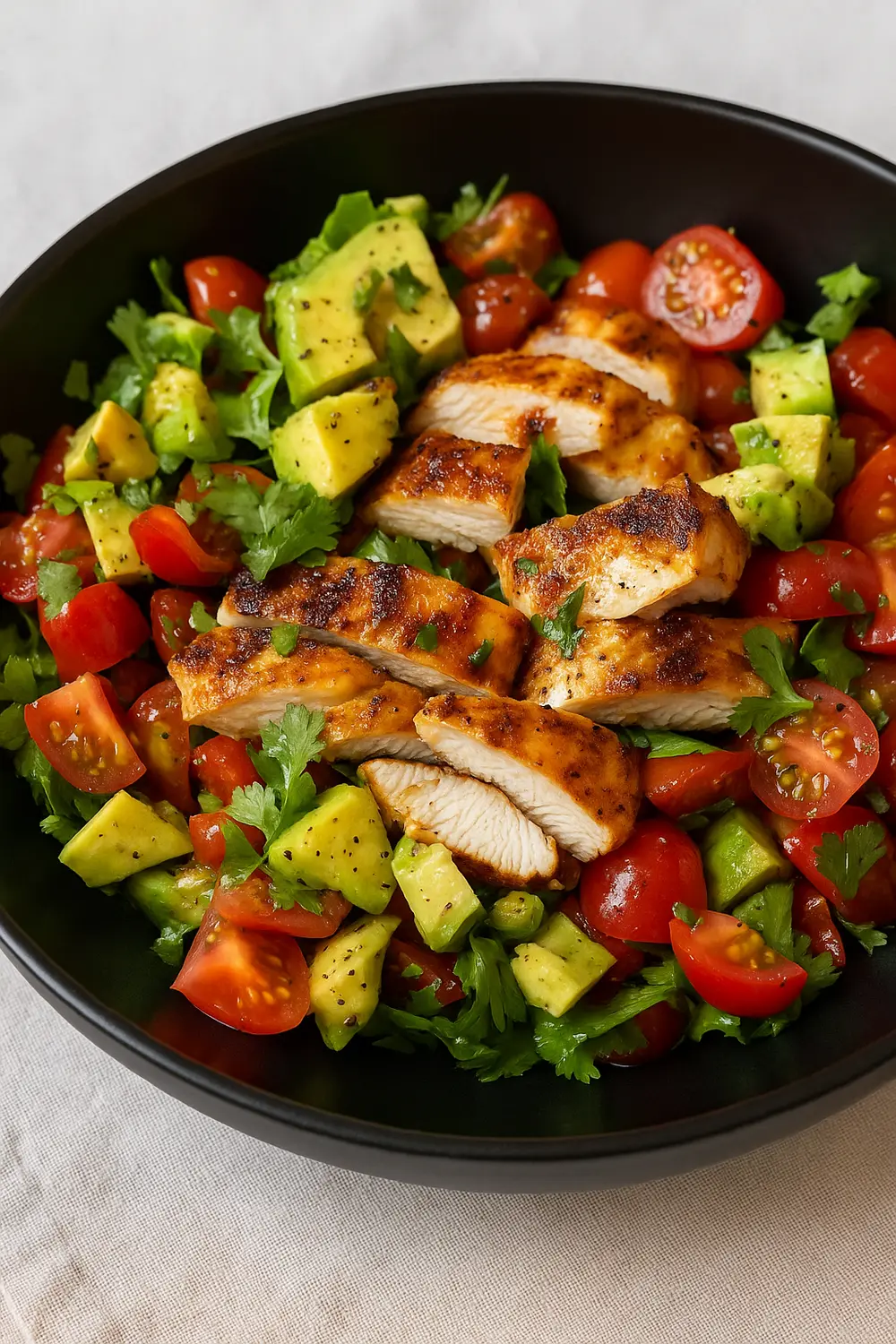
Day 2
Breakfast:
- Berry Protein Oatmeal: Warm oatmeal made with water or low-fat milk, mixed with vanilla protein powder and topped with sliced strawberries, blueberries, and a sprinkle of chopped walnuts.
Lunch:
- Grilled Shrimp Tacos: Juicy shrimp marinated in lime and spices, grilled to perfection, and wrapped in low-carb lettuce or tortilla alternatives, topped with crunchy slaw and avocado crema.
Dinner:
- Chicken Avocado Salad: Mixed greens topped with grilled chicken strips, cherry tomatoes, cucumber, shredded carrots, and avocado slices. Dress with a squeeze of lemon and a drizzle of olive oil. Serve with a side of whole-grain pita.
Snack:
- Veggie Sticks & Hummus: Carrot and celery sticks dipped in hummus for fiber and protein.

Day 3
Breakfast:
- Spinach and Feta Omelet: Two eggs or egg whites cooked with fresh spinach, diced tomatoes, and a sprinkle of feta cheese. Serve with a slice of whole-grain toast and sugar-free fruit jam.
Lunch:
- Chicken with Cabbage Soup: A hearty yet light soup made with tender chicken, cabbage, bok choy, and onions simmered in a savory tomato broth, high in protein, low in calories, and nutrient-dense.
Dinner:
- Stir-Fry Beef and Veggies: Stir-fried lean beef strips with broccoli, bell peppers, onions, and snap peas in a light teriyaki or soy-ginger sauce and served over cauliflower rice or a small portion of brown rice.
Snack:
- Roasted Chickpeas: Crispy oven-roasted chickpeas seasoned with paprika and garlic for a crunchy plant-based snack.
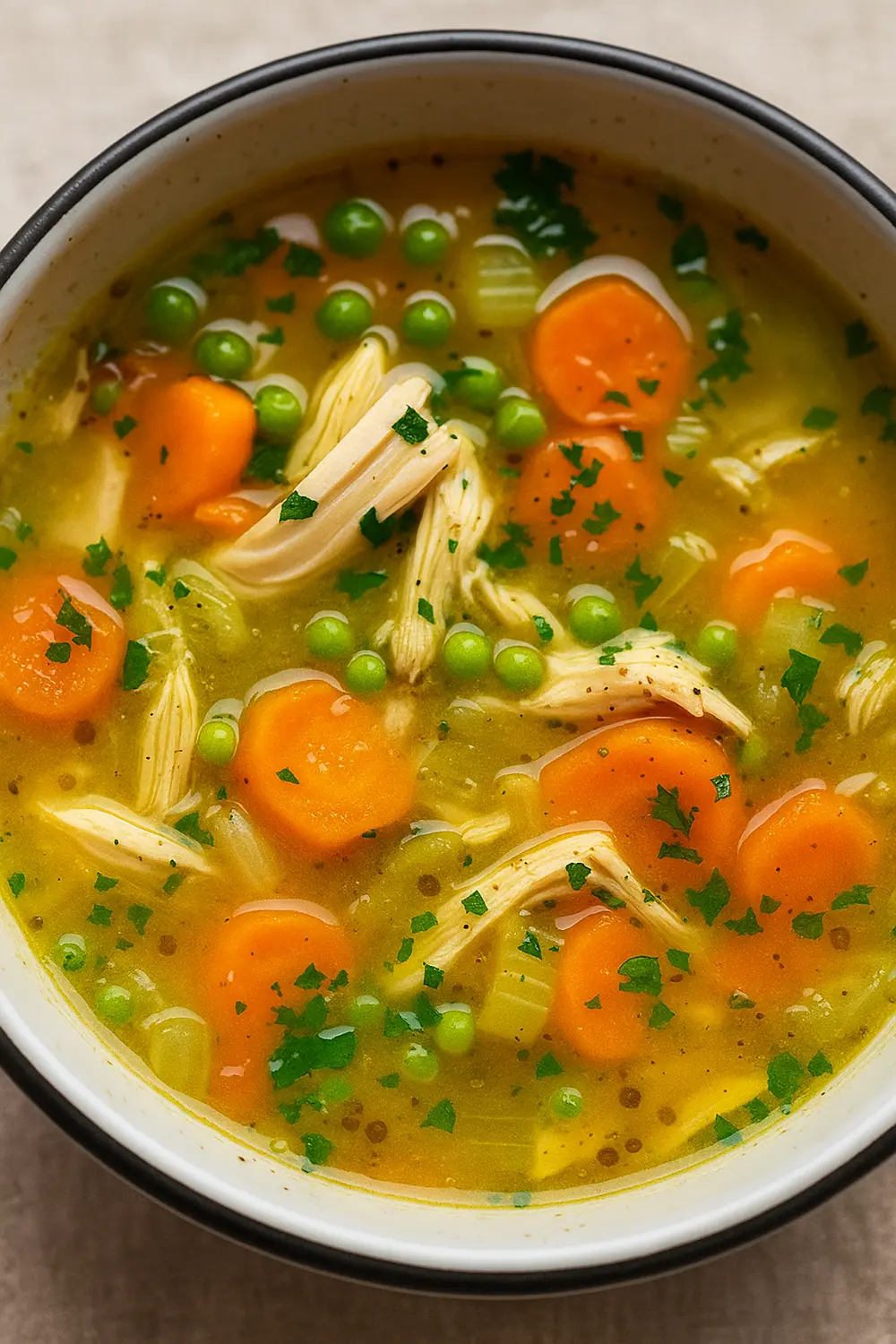
Day 4
Breakfast:
- Veggie Breakfast Burrito: Scrambled eggs with sautéed zucchini, bell peppers, onions, and black beans, wrapped in a whole-wheat tortilla. Top with salsa and a spoonful of avocado.
Lunch:
- Healthy Chicken Soup: A bowl of homemade chicken vegetable soup, brimming with shredded chicken, bright green peas, sliced carrots, celery, and fresh parsley in a turmeric-infused golden broth.
Dinner:
- Moroccan Tagine: A fragrant North African–inspired dish featuring tender chicken, olives, and apricots, simmered in a blend of spices for a healthy ozempic dinner meal.
Snack:
- Apple Slices with Almond Butter: Thin apple slices spread with a light layer of almond butter.
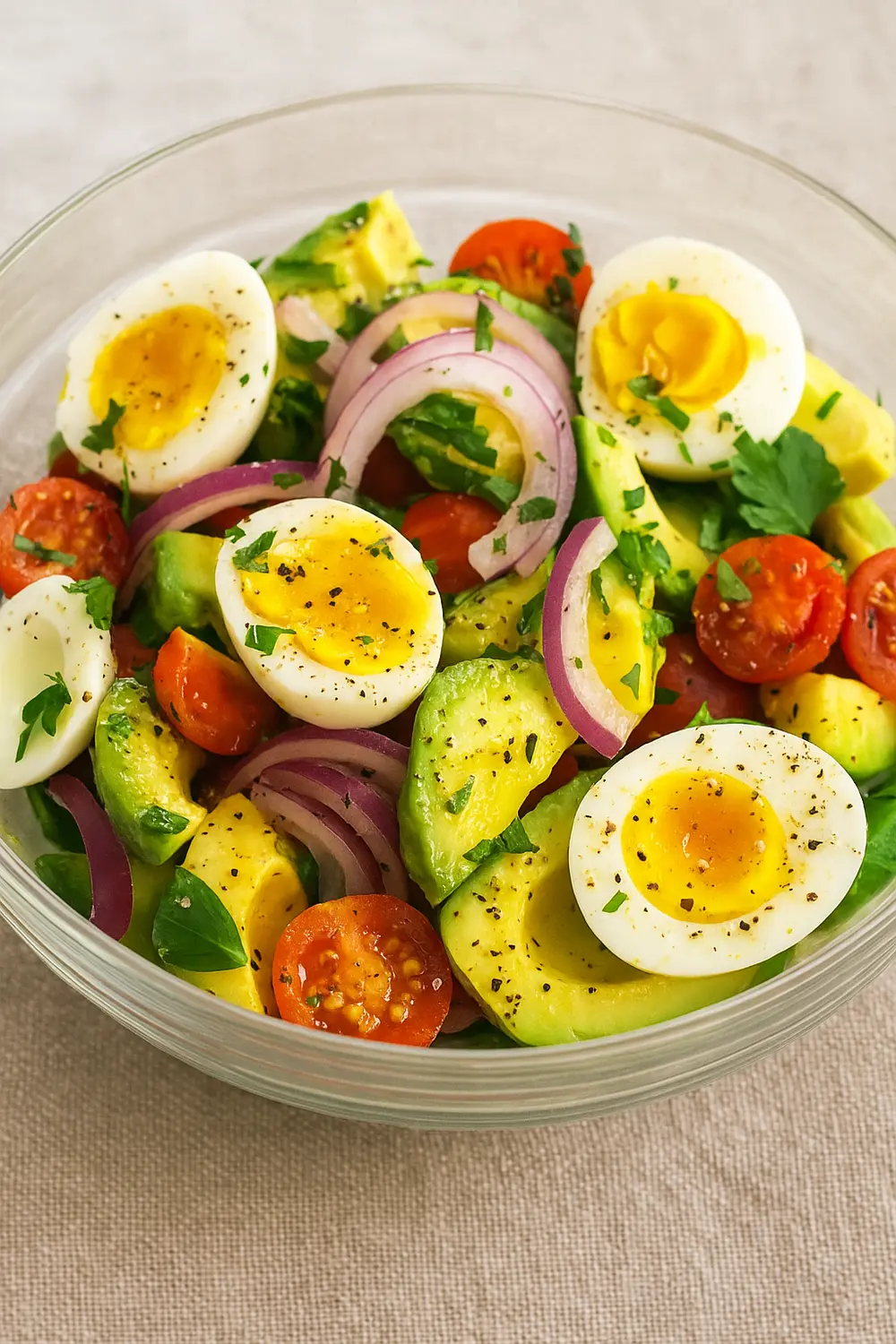
Day 5
Breakfast:
- Berry Smoothie Bowl: Blend unsweetened almond milk with spinach, a handful of berries, and protein powder. Pour into a bowl and top with sliced banana (sparingly), hemp seeds, and a teaspoon of peanut butter.
Lunch:
- Avocado Egg Salad: A healthy protein-rich mix of halved hard-boiled eggs, creamy avocado chunks, juicy cherry tomatoes, sliced red onion, and fresh parsley, all seasoned with cracked black pepper.
Dinner:
- Grilled Chicken with Mixed Greens: Juicy grilled chicken breast served over a bed of crisp greens, cucumbers, and cherry tomatoes, dressed lightly with olive oil and balsamic for a clean, balanced plate.
Snack:
- Vegetable Soup: A cup of homemade vegetable broth-based soup (tomato or chicken broth with veggies) to sip if you’re a bit hungry.

Day 6
Breakfast:
- Chia Seed Pudding: Soak chia seeds in unsweetened almond or coconut milk overnight. In the morning, top with diced kiwi and a few almonds. High in fiber and omega-3 fats.
Lunch:
- Coconut Lime Fish Soup: A healthy fish soup featuring tender white fish simmered in a fragrant broth with lime, coconut, garlic, and chili, and topped with fresh parsley and served with lime wedges.
Dinner:
- Salmon Salad: Canned or grilled salmon mixed into a salad of greens, cucumber, radishes, and a boiled egg. Dress with olive oil, lemon, and dill. Serve with whole-grain crackers.
Snack:
- Cottage Cheese with Sliced Veggies: Creamy cottage cheese paired with crisp cucumber, peppers, and tomatoes, a nutrient-dense, low-carb snack that curbs cravings.
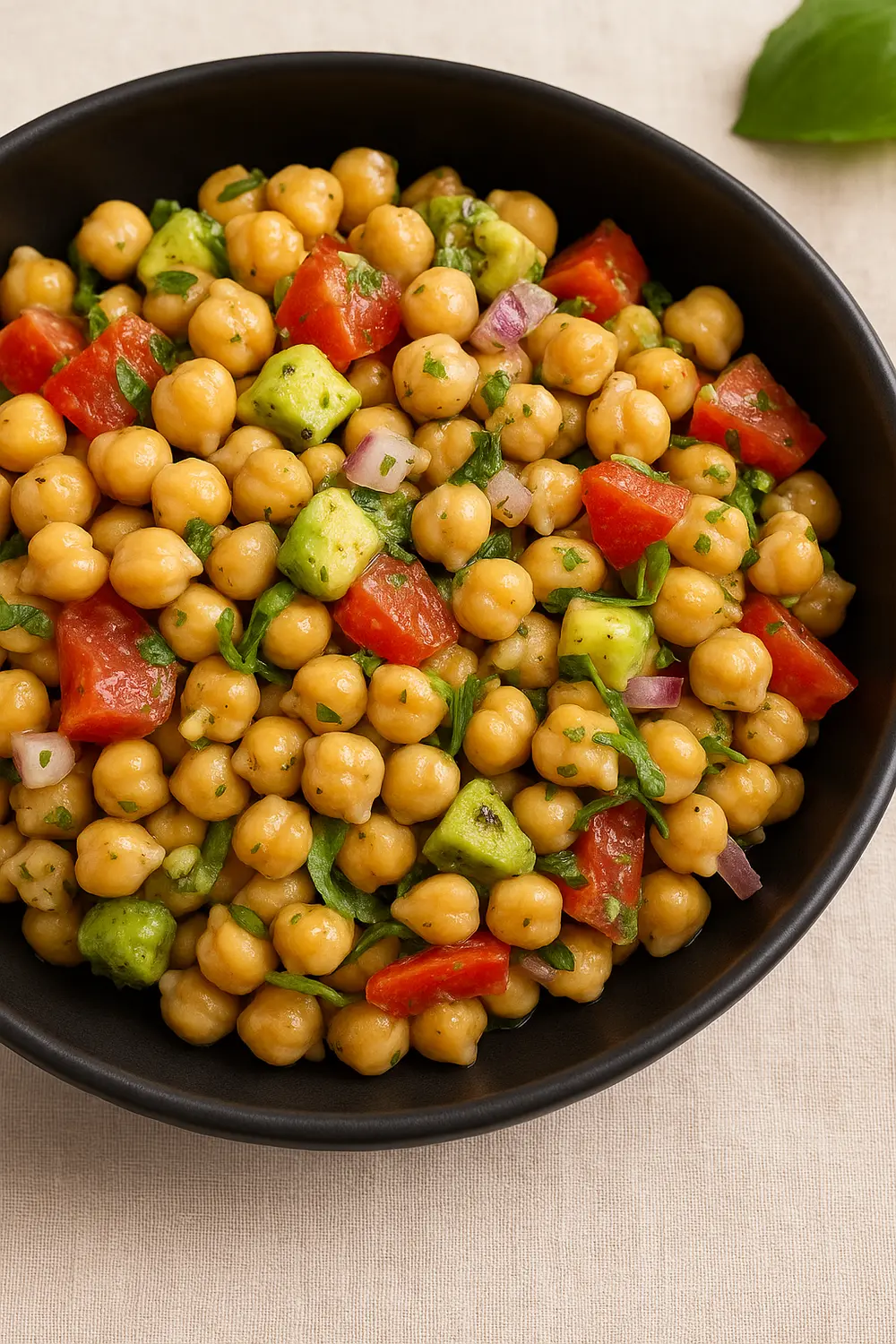
Day 7
Breakfast:
- High-Protein Cereal: A serving of whole-grain, low-sugar cereal with milk or unsweetened plant milk, topped with sliced strawberries. Add a tablespoon of ground flaxseed for fiber.
Lunch:
- Chickpea Avocado Salad: A refreshing chickpea avocado salad made with chickpeas, ripe avocado, juicy tomatoes, red onion, and fresh herbs, and tossed in a light lemon-olive oil dressing.
Dinner:
- Baked Cod with Veggies: Baked white fish (cod or tilapia) seasoned with lemon and herbs, served alongside roasted Brussels sprouts and baby carrots tossed in a little olive oil.
Snack:
- Hard-Boiled Egg with Avocado: Simple, filling, and nutrient-rich, protein-packed eggs with creamy avocado slices keep hunger in check between meals.
Ozempic Tips and Best Practices
To maximize comfort and results on an Ozempic diet, consider these practical Ozempic tips:
- Take Ozempic Before Meals: Ideally, inject Ozempic around 30 to 60 minutes before your biggest meal. This timing helps the drug start working as food arrives in your stomach, reducing nausea.
- Pair Carbs with Protein: When you do eat carbohydrates (grains, starchy vegetables), always include a good protein source. This balances blood sugar and keeps you fuller longer. For example, have eggs or Greek yogurt with your oatmeal, or chicken with rice.
- Eat Slowly and Mindfully: Chew food well and eat at a relaxed pace. Ozempic slows digestion, so eating slowly can help you notice satiety signals and prevent overeating and reduce indigestion.
- Balance Each Plate: Aim for half of your plate to be vegetables, one-quarter lean protein, and one-quarter whole grains or starchy vegetables. This “balanced plate” approach ensures plenty of fiber and protein, which support Ozempic’s effects.
- Hydrate Wisely: Drink plenty of water and herbal teas. Water-rich, low-calorie beverages (like broth or unsweetened drinks) are least likely to cause side effects. Staying hydrated helps prevent constipation, a common Ozempic side effect.
- Introduce Fiber Gradually: If you increase fiber (e.g. beans, oats, cruciferous veggies), do it slowly. Too much too fast can cause gas or bloating, especially with Ozempic. Start with small portions of high fiber foods and build up.
- Watch Fat Intake at Dinner: Limiting fatty foods in the evening may reduce overnight nausea or reflux. For example, skip an evening coffee with cream or a heavy cream sauce at dinner.
- Snack Smart: If you need a snack between meals (because Ozempic can make meals very filling), choose protein-rich, low-sugar snacks. Good choices include nuts/seeds, a hard-boiled egg, Greek yogurt, cottage cheese, or cut vegetables with hummus.
Benefits of a Semaglutide Diet Plan
Following a semaglutide diet plan is about making smarter food choices that work with Ozempic to support your health. Here are some of the key benefits you can expect:
- Enhances Weight Loss: While semaglutide helps reduce appetite and slow digestion, pairing it with a structured semaglutide diet plan that’s rich in protein and fiber maximizes weight loss results.
- Supports Blood Sugar Control: Foods like whole grains, lean proteins, and vegetables help stabilize blood sugar levels. This lowers spikes and crashes, making the semaglutide diet plan especially effective for people managing type 2 diabetes or prediabetes.
- Preserves Muscle While Losing Fat: High-protein meals are a key part of the Ozempic diet meal plan. They prevent muscle loss during weight loss, helping you maintain strength and metabolism.
- Improves Insulin Sensitivity: Eating high-protein, high-fiber meals on an Ozempic diet plan helps the body use insulin more effectively, reducing resistance over time.
- Improves Digestion and Satiety: A high-fiber semaglutide diet promotes healthy digestion, regularity, and longer-lasting fullness. Combined with the appetite-suppressing effects of Ozempic, it helps curb cravings naturally.
- Reduces Risk of Overeating: Since the Ozempic diet slows gastric emptying and the foods included are filling but nutrient-dense, it becomes easier to control portion sizes without feeling deprived.
- Promotes Heart Health: This Ozempic diet plan features foods such as leafy greens, whole grains, and healthy fats, which support healthy cholesterol levels, reduce inflammation, and improve cardiovascular health.
- Builds Sustainable Eating Habits: An Ozempic meal plan is not a fad diet. It focuses on real, wholesome foods and balanced Ozempic meals you can enjoy long term, even beyond your semaglutide treatment.
Final Remarks
Following an Ozempic diet meal plan is one of the most effective ways to support your weight loss and blood sugar goals while on semaglutide.
By choosing high-protein, high-fiber, nutrient-rich foods and avoiding heavily processed, high-sugar meals, you’ll make Ozempic work smarter for you, helping curb cravings and keep blood sugar steady.
Remember, Ozempic works best when combined with healthy eating habits, regular physical activity, and lifestyle changes that you can maintain long-term.
And most importantly, always consult your healthcare provider before starting or adjusting your Ozempic diet plan to make sure it’s the right fit for your health goals.
You may also be interested in these;
- High protein low carb diet for beginners
- Low calorie high protein diet for weight loss
- Rice diet meal plan for weight loss
- Mounjaro diet plan
- Low carb meal plan for blood sugar control
- Calorie deficit diet plan
- Gluten free diet for beginners
FAQs
What is a semaglutide diet plan?
A semaglutide diet plan means essentially the same as an Ozempic diet, since Ozempic is semaglutide. It’s a holistic eating approach for people taking GLP-1 drugs.
The focus is on nutrient-dense foods (non-starchy vegetables, lean proteins, whole grains, nuts) that support blood sugar control and weight loss.
How many calories should I eat daily on Ozempic?
Ozempic doesn’t prescribe a calorie count, but weight loss generally requires a moderate calorie deficit. Rather than fixating on calories alone, focus on nutrient-dense foods that help you feel full (protein, fiber).
Should I follow a low-carb or keto diet with Ozempic?
You don’t have to go full keto unless your doctor advises it. Ozempic works with a variety of healthy eating patterns.
The important thing is to cut out junk carbs (sugary snacks, white bread) and fill up on vegetables and whole grains as a carb source.
Should I eat before or after injecting Ozempic?
It’s recommended to take Ozempic before your meal, so that the medication is active when food arrives. This can help reduce nausea and better blood sugar control.
Can I eat fruits on Ozempic?
Yes, fruits are part of a healthy Ozempic diet. Opt for lower-sugar fruits like berries, apples, and citrus. These provide fiber and nutrients without large sugar spikes.

